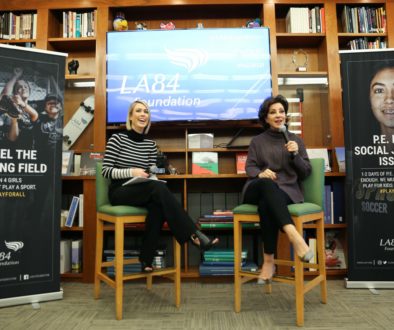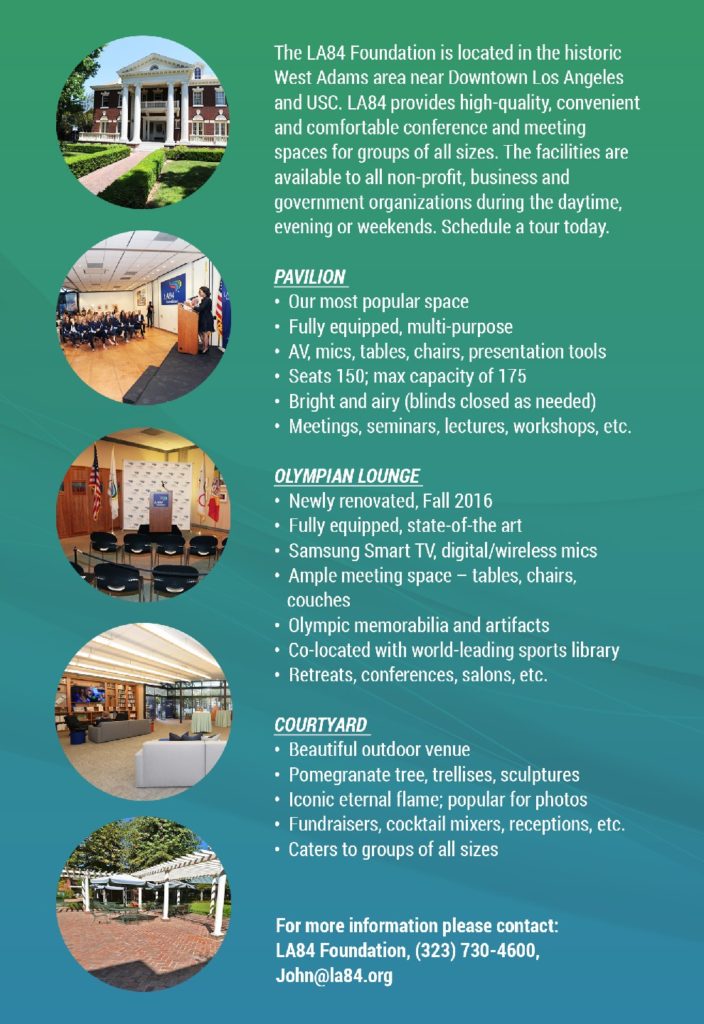SL Interview: Warren St. John on Refugees, Soccer, and Starting Over in America
The city of Clarkston is located about ten miles northeast of Atlanta, Ga. In 1980, the town’s population was 90 percent white, but that soon changed – and fast. An abundance of inexpensive housing and Clarkston’s proximity to Atlanta were two key factors why the town became, in the late 1980s, a resettlement hub for refugees from the world’s most troubled corners: Afghanistan, Bosnia, Iraq, Kosovo, Liberia, Somalia and Sudan.
“From 1996 to 2001, more than 19,000 refugees from around the world resettled in Georgia,” according to Warren St. John, author of “Outcasts United: A Refugee Team, An American Team” (Spiegel & Grau; Amazon). “Some have endured unimaginable hardship to get here: squalor in refugee camps, separation from siblings and parents. One saw his father killed in their home.”
A reporter with The New York Times, St. John was intrigued by the inherent tension between the newly arriving refugees and the residents of Clarkston. He chose to tell this modern-day American immigration story through three boys’ youth soccer teams formed from the teenage talent of the refugee families. They decided to name themselves The Fugees.
A good chunk of St. John’s book focuses on the extraordinary efforts of coach Luma Mufleh, herself an immigrant from Jordan, to keep the youth soccer program afloat. She faces unique challenges, including language, cultural, and religious differences among her own charges. And, in the course of the book, St John recounts how she faces her own demons.
This is St. John’s second book. His previous work, “Rammer Jammer Yellow Hammer: A Journey into the Heart of Fan Mania,” was his personal account of following the die-hard, tailgating corps of University of Alabama football fans.
SportsLetter interviewed St. John by phone from his home in New York City.
–- David Davis
SportsLetter: I understand that the book started out as a series of three articles for the New York Times, beginning in January of 2007. How did you come to hear about the Fugees?
Warren St. John: Everyone has this wrong, so let me correct the record. It was a book idea before it was an article idea. The articles came out of research for the book, not the other way around. I was in Atlanta giving a talk for my first book, and a reader reached out to me when I was down there and invited me to dinner. He mentioned that he worked in refugee resettlement in Atlanta.
Being a reporter, I started asking a lot of questions: “What do you mean, refugees in Atlanta? Refugees from where? How many are there? How many different countries?” He told me about the resettlement situation in and around Clarkston, and then he said, “You should check out this youth soccer team – the Fugees.”
When I came back through Atlanta, I went to the game that I describe in the introduction of the book. I flew down a few other times after that and began to get a sense of the scope of the story: how incredibly diverse Clarkston was because of these refugees and how quickly it had become that way, the coach’s amazing story, all the players and their families with complicated histories from different parts of the world and the town itself. As soon as I saw what I saw, I had this flash of recognition that this was what my next book was going to be about. I just knew.
SL: You’re originally from Birmingham. How did your background inform the book?
WSJ: I think it had everything to do with my immediate interest in the story. If I was from New York, I don’t think that I would’ve picked up so quickly how unusual it was that there was this substantial refugee community from 50-plus nations around the world in a small Southern town. I immediately understood that that was going to be interesting because I spent a lot of time in small Southern towns.
I think it probably helped that I speak the language, culturally. I’ve been going to Atlanta my whole life. I have a familiarity with the layout of the town. And, Atlanta and Birmingham had a lot in common, in terms of their histories, until Atlanta got the international airport. The two cities diverged radically at that point. In the next three-four decades, Birmingham remained stagnant and xenophobic and Atlanta became this boomtown, the economic engine of the South and a place where black Americans were able to assert themselves. The airport changed the whole story. It opened Atlanta to the world and was one of the reasons why the Olympics came to Atlanta and not some other Southern city.
SL: How did this suburb of Atlanta become a center for resettlement for refugee families?
WSJ: The answer to that lies in the story of Clarkston’s history as a town. It had been a small, residential community with maybe 500 houses. In the 1960s and 1970s, as Atlanta was growing, developers built all these apartment complexes that are probably familiar looking to all Americans: two-story apartment complexes, with big parking lots designed for commuters.
Starting in the 1980s, white flight starts to kick in. White folks moved out to suburbs farther away from Atlanta, more toward the north. A lot of the apartment complexes in Clarkston become Section 8 – government-subsidized housing – and fell into disrepair. There was gang activity and crime.
For resettlement agencies, Clarkston was perfect for refugees because it’s affordable and near public transportation and near economic centers that can absorb low-skilled workers who don’t speak English, at least initially. The refugees could handle jobs in the hospitality industry as maids or in the chicken-processing plants.
SL: What were the challenges that the refugees faced and, in particular, what were the challenges that the youth faced in coming to America?
WSJ: First, they have no economic advantage whatsoever. Most refugees arrive having been given a loan for the price of the one-way airline ticket to America. So, they arrive in debt, with few if any possessions.
Second, they’re culturally bereaved in the sense that they’ve had to leave behind the familiar, almost always under duress. They often have psychological issues, like post-traumatic stress and a sense of profound emotional loss at having given up their entire life and community.
Most people who work in resettlement say, the younger you are, the easier the transition will be. The really young kids are amazingly adept at picking up a new language and working off social cues. It’s the kids who are 13, 14, 15 and even older who face an intense struggle. The first big issue has to do with identity. They may be identified nominally as, say, Liberian or Congolese. But then they may have spent time in a refugee camp that wasn’t in their country, for as long as five years. So, they’re Liberians who don’t remember ever living in Liberia, or they’re Congolese who spent most of their sentient years of childhood in Rwanda or Tanzania.
So, they’re not quite of the place where they originated, and yet they’re also not quite American. They’re betwixt and between. They’re in the public school system with kids who very much identify themselves as American, who have their own local culture from a largely urban, inner city environment. These are African-American kids who see themselves as completely separate from African refugee kids.
So, the refugee kids have to create a new reality, a new consistent world for themselves. It’s very difficult because everything is shifting all around them.
SL: You write in the book that many of these kids are “between worlds.” How does that apply with their parents?
WSJ: There can be this inversion of the family power structure, where parents lose a sense of control over their children, especially when the children speak English better than their parents. These are not bad kids, but they’re testing the boundaries and using what power they have. It was common to hear stories from refugee parents that their kids would say something like, “If you punish me, I’ll tell at school.” That’s very threatening for parents because they’re in no position to masterfully navigate the U.S. child services system in the event that a principal calls them in and says, “I understand that you disciplined your son this way.”
SL: How do the kids on the Fugees soccer teams come to view soccer: As salvation? As after-school fun? As a way to integrate into American society?
WSJ: I think it was all of the above and more. Number one, most of the kids share a natural passion for the game. The places where they come from, that’s normal. They love the game and they love playing it.
Once they start watching coach Luma do what she does, the relationship to the program seems to change. That’s because one of the things she provides the kids is a remarkable consistency. If she says she’s going to bring something to your house at a certain time, she does it. If she says she’s going to advocate on your behalf at school, she does it.
For a lot of these kids, that’s a very new experience. They’re largely from single-parent families, so mom or dad is completely overwhelmed by the daily challenges of their lives. They don’t have a chance to follow up with the principal at school or make getting new soccer cleats a priority. Luma not only makes it a priority, but she follows through. She provides this framework for responsibility and consistency and dependability that raises the bar for the kids in her program.
Before the soccer games, she’ll tell the kids, I’ll meet you at the public library at, say, 9 a.m. on Saturday. Most of these kids’ parents aren’t in position to wake them up and make them breakfast the way an American parent would. They’re either working the night shift or they have to work on weekends and are already out the door. It falls on the kids to get themselves ready: to wake themselves up, get something to eat and walk a mile to meet the bus. That sounds like a tall order until you realize that they have a model in Luma of someone who constantly does exactly what she says she’s going to do.
SL: How would you describe her style of coaching?
WSJ: I played youth sports, and I don’t think I had a coach who was as remotely tough or demanding as Luma is towards her players. To an American ear, there are definitely moments when you think, “Wow, she’s so tough and so harsh on these kids.” I’m sure there will be American parents who read the book and say, “I’m not sure I’d want my child to have a coach who speaks that directly.”
And yet, when a coach gets mad at you when you’re young for not doing the things you’re supposed to do, in a way there’s an implicit compliment there. An adult is saying to you: “I think you’re capable of being responsible to this degree.” She doesn’t ask them to do anything that’s unreasonable. She’s asking them to do what they’re coached to do. She’s asking them to show up on time and do the things they’ve agreed in advance to do to be a part of the team. Then, she’s holding them to that standard. There’s something empowering in that. It’s an incredible confidence builder for the kids who stick with it.
Now, if there was something arbitrary about her behavior or if you weren’t familiar with her other qualities, then I think it would be more of a cause for concern. But when she’s yelling about soccer, it’s because she has a set of expectations in the context of the team and the game. Even if she doesn’t soften her tone, she’s still always that consistent person leading by example. Some people might say that these are contradictory components. Maybe they’re just complementary components.
SL: You write about the “super diversity” of the Fugees, with these kids from different countries with different languages and religions and backgrounds. How much of a challenge is that for coach Luma?
WSJ: On one level these kids have everything in common. They were all dropped off at this strange corner of the universe together. In another way, they have little in common. There are kids on the teams whose families are extremely devout Christians and there are kids on the team whose families are extremely devout Moslems.
That’s why the story of the Fugees is so interesting. Here you have this group of kids from 12, 13 different countries, and they’re finding a way to communicate with each other and work together to improve over time and coalesce. Around them, there’s this community of adults that’s having a much harder time of it.
Luma herself says that one of the challenges she faces – and it’s one she continually faces – is that every year the team is different. Some people move away, new people arrive. Every season she has to remake her teams because the composition is never fixed. It’s an ongoing project of the teams to try to forge some togetherness out of this group of kids.
SL: How were the Fugees treated by other teams and other parents?
WSJ: I saw a broad range of responses. I saw parents who were immediately interested and curious about where all these kids were from and how they came to be in Georgia. I sat behind a family at a tournament in Savannah who belittled the Fugees for their accents and derided their style of play as street soccer in this nasty, unappreciative way. I know that, at least one game, parents on the sidelines used a racial epithet directed at the Fugees.
Luma has said that the Fugees inspire strong responses. When they take the field, they look so unlike any other team in Atlanta. There are other teams that might have a single African player, and there are definitely teams that have Latino players. But there’s no team that has this crazy mixture of Bosnians and Africans and Iraqis and Afghanis.
Then there’s fact that they have a woman coach. I never saw another woman coaching a boys’ team.
SL: How about in the town of Clarkston, did the reaction to the Fugees change over time?
WSJ: I think things have changed a lot. The Times’ front-page story [the first of which appeared in January of 2007], just by shining a spotlight on all the complicated relationships, caused some degree of introspection all-around. Ultimately, it’s been much more positive than negative.
But when I was there, that was not necessarily the mode. There was not great concern about the Fugees among people not directly connected to the Fugees program.
SL: Did your articles about the Fugees affect what happened in the book?
WSJ: I had the good sense to understand that doing an article for the Times was going to change things so much that I needed to do all my reporting for the book up front. In other words, just by writing about something you change it.
My reporting is about this snapshot in time, when I was there on the ground and immersed in this world. The Times’ story changed that world, to a large degree, just like any big article about a small community is going to impact that community.
Editor’s Note: In the Epilogue of the book, St. John writes that, after his Times article was published, “The newspaper’s readers donated to the Fugees in amounts large and small, and a deal was made for film rights to the Fugees story. The donations and film money allowed Luma to buy the Fugees their own bus and equipment.
SL: You write how the Fugees’ access to a decent soccer field in town became a tug-of-war issue. Why were the mayor and others so opposed to allowing the team to practice permanently on a decent field in the town?
WSJ: One of the things that’s so interesting is the way the detractors of the Fugees in city government have looked at the whole situation. They can’t get their heads around the situation in any other way except to think: these people want use of this field for free. They want something for free and that’s not fair. They ought to pay for it.
It’s a form of reactionary defensiveness that I think is endemic to the South. But I think everyone understands that the value of a social services program is a lot more complicated than that. The real challenge for a local government is to look at issues in terms of what’s the cost-benefit analysis?
Here’s a woman who, through her own sweat equity, is taking kids from the community and giving them something safe to do after school, providing a role model and creating new role models, tutoring kids and giving them opportunities. And she’s doing it for next to nothing. The overall benefit to the community is extraordinary. In fact, what communities need are more people like Luma. So, it seems to me that the prudent position would not be to try to pressure this person who’s giving so much to the community to pay more for use of an otherwise empty field.
The alternative is to have all these kids hanging out after school. That doesn’t help the community, that doesn’t help property values, that doesn’t help public safety. That doesn’t help these kids.
SL: What’s been the ultimate outcome: do they still have use of the field?
WSJ: The Fugees are still on the field in large part because the mayor got tangled up in his explanations of why he kicked them off the field. He kept telling different stories about why he did that. For instance, he told me that it was because there was going to be another youth sports program in the park. I called around and none of the other city council members had heard anything about that. So, he had to backtrack.
SL: Has playing soccer helped the Fugees to integrate into society at large or did it just show off the wide gap between them?
WSJ: I think overwhelmingly the former. There’s no doubt that when you play a competitive sport in a public arena, that very act of engaging other people is going to bring certain issues to the fore that otherwise might not be visible. If everyone stayed home in their apartments, these issues would be a lot harder to spot.
Soccer is an amazing sport. You’re playing right there with another person. You don’t have pads or face masks. You’re talking to each other during the game. You talk after the game. You might see others at some clinic or some tournament later on. The kids are getting exposed to something totally new and different. And, it goes both ways. There are kids from some neighborhoods in Atlanta who might never meet another person from a foreign country, except that they played a soccer game against the Fugees. Just like there are kids on the Fugees who have never left Clarkston except to go to away soccer games. They’re seeing America for the first time through this soccer prism.
SL: Your previous book was about the University of Alabama football fans. How was doing this book different than doing “Rammer Jammer”?
WSJ: I’m a person who, even when I’m doing stories at the paper, I love the experience of throwing myself into something completely new and foreign. For me, the thrill of journalism is putting yourself in that situation and trying to learn about it in a way that allows you to tell the story authoritatively. It’s the thrill of the personal education that you submit yourself to when you dive into a world you don’t understand.
On some level I understood the world and the people in “Rammer Jammer.” I come from Alabama. But there was a part of that culture that I didn’t understand up close. I knew that it was there, but I hadn’t figured it out.
With the Fugees book, I was able to recognize that this would be an interesting community to discover. There are a million Clarkstons in Queens; it’s not that unusual here in New York. I knew it would be different in Georgia, and I wanted to understand that. I wanted to understand the lives of the people who came to America for resettlement. I wanted to learn about how these people got here and what they suffered through in order to make a life for themselves in this place.
What’s so interesting about Clarkston is, it’s kind of the next 25 years in America on fast forward. In five to seven years, this town went through 50 years of demographic change. So, it’s important to see what that looked like up close to get a sense of what’s coming, to see the challenge of creating community in a world where everyone around us is so different.




